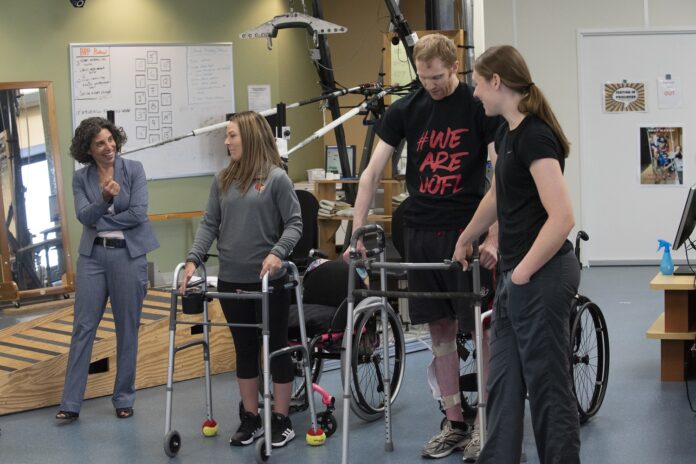
Researchers at UofL made news worldwide in 2018 when two people diagnosed with complete spinal cord injuries recovered the ability to walk thanks to experimental use of a therapy known as epidural stimulation. The news gave hope to people living with complete spinal cord injuries, a diagnosis that historically meant they were unlikely to regain function below their level of injury.
Despite these significant results, use of epidural stimulation outside a research lab setting to restore function for people with spinal cord injury thus far has been hampered by several limitations, including the use of a technology that was designed for patients with chronic, intractable pain – not those with spinal cord injury.
Applying this therapy for spinal cord injury is a big step closer to use outside the research lab thanks to a $7.8 million grant from the National Institute of Neurological Disorders and Stroke, one of the National Institutes of Health. The grant will fund work at UofL’s Kentucky Spinal Cord Injury Research Center in collaboration with medical device manufacturer Medtronic to develop and test software applications specifically designed for spinal cord injury that work in concert with Medtronic’s commercially-available device, Intellis, which is indicated as a spinal cord stimulator for chronic pain. The five-year project, funded through the NIH BRAIN Initiative, is focused on incorporating technology to improve control of locomotor and bladder function using epidural stimulation.
“We have seen excellent results with epidural stimulation in the lab, but these enhancements to the technology system will make it much easier to implement this therapy out in the community. Integrating multiple systems will allow people with chronic spinal cord injuries to benefit from stimulation on a daily basis by reducing the need to monitor and manually revise stimulation settings,” said Claudia Angeli, assistant professor of bioengineering in the UofL J.B. Speed School of Engineering and director of the Epidural Stimulation Program at KSCIRC. Angeli and Maxwell Boakye, neurosurgeon and clinical director of KSCIRC, will lead the project.
Medtronic epidural stimulators first were used for spinal cord injury in 2009 under an Investigational Device Exemption with the FDA during research at UofL led by Susan Harkema, professor of neurological surgery and associate scientific director for KSCIRC. The epidural stimulation therapy involves implanting a neurostimulator under the patients’ skin and implanting electrodes in the epidural space of the lower spinal cord, which together deliver mild electrical impulses to the spine.
While epidural stimulation has been proven to provide effective relief for chronic pain, there are limitations in functionality when treating individuals with spinal cord injury. For example, the stimulation settings that allow individuals with spinal cord injury to stand are different from settings that allow them to walk, while a third configuration is required to help with bladder function and so forth. The devices that researchers use today must be programmed manually for each individual function.
The goal of the new project is to develop integrated, closed-loop programming for multiple systems, specifically locomotion and bladder function, using wireless sensors to monitor the user’s condition and adjust stimulator settings as needed. Working with Medtronic, the UofL researchers will develop learning programs for the closed-loop system and integrate the programming with commercially available epidural stimulators, as an investigational use.
“This device will be customized for the needs of individuals with spinal cord injury, which will require less manual interaction and lead to more positive outcomes in both locomotion and bladder function, dramatically improving the future of neuromodulation for spinal cord injury,” said Boakye, chief of spinal neurosurgery at the UofL School of Medicine, neurosurgeon with UofL Health – UofL Physicians and lead neurosurgeon for implantation of the device.
During the first phase of the study, the researchers will develop learning algorithms and the closed-loop system, working with the Medtronic’s Intellis Spinal Cord Stimulation platform. This phase calls for eight individuals to receive implanted stimulators and either locomotor or bladder interventions to develop learning algorithms, which later will be integrated in closed-loop controls. Those data and technical tools then will be applied to a second group of eight individuals who have not received prior training.
“By monitoring multiple systems and enabling the controller to adjust stimulation without direct input from the user, these improvements will make this device a powerful tool for improving the lives of people with spinal cord injury,” said April Herrity, an investigator on the project.
The 2018 breakthrough was the result of years of research by the UofL team, which found that applying electrical stimulation to the lower spinal cord, combined with physical therapy, allows unexpected degrees of recovery in people with complete spinal cord injury. Research participants are able to move voluntarily, stand and take steps, in addition to experiencing improvements in blood pressure regulation, bowel and bladder function and other common health issues associated with spinal cord injury.
“One of the main obstacles to making this therapy available to patients has been the need for programming specific for spinal cord injury,” said Harkema, also an investigator on this project. “This new work will promote the safe, long-term use of the therapy in the home and community, allowing people with spinal cord injury to benefit from the discoveries we have made over the past two decades.”
“Medtronic is excited to be collaborating with the University of Louisville on research related to the use of spinal cord stimulation to improve function for individuals with spinal cord injury,” said Charlie Covert, vice president and general manager of Pain Therapies, part of the Neuromodulation Operating Unit at Medtronic. “Collaboration is vital to innovation in this space in order to meet the needs of this important patient population.”
































